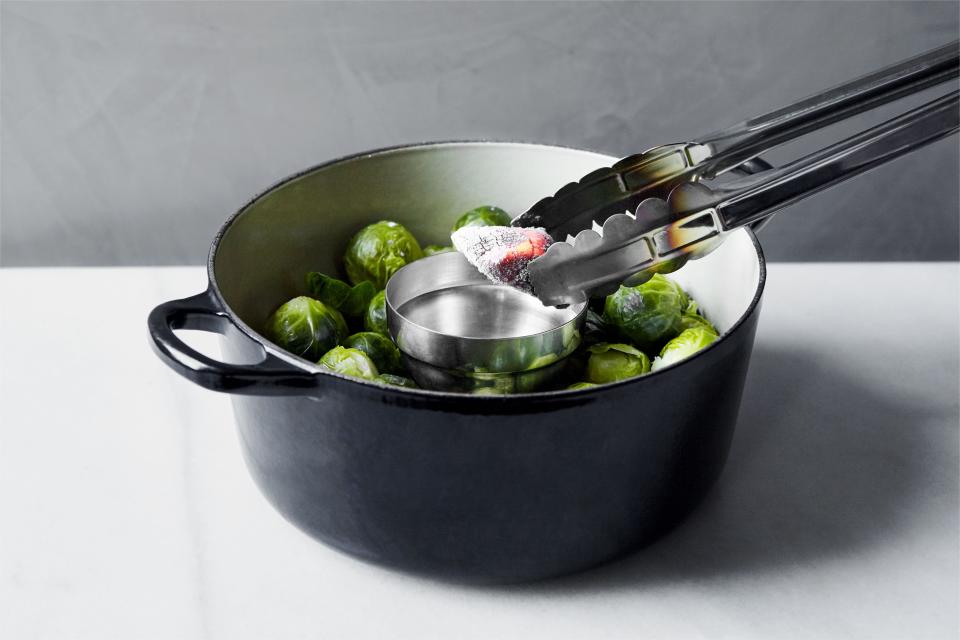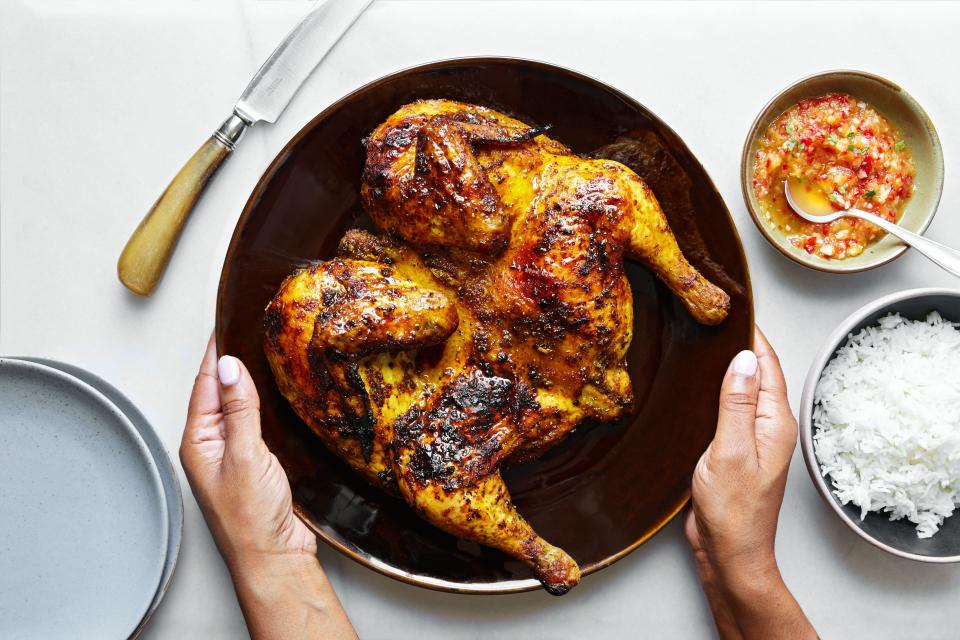The Dhungar Method Is the Smoky Secret to Incredible Roast Chicken, Rice, and More
The dhungar method is a South Asian way of introducing a buttery, smoky flavor as a finishing touch to food. It involves an encounter between ghee (clarified butter) and hot coals in a smoking chamber—most commonly a lidded pot. This interaction produces the smoky, buttery aroma that will perfume any food that you trap inside that pot.
The goal of the dhungar method is not to hot-smoke food; the heat from that one piece of coal is not enough for any degree of cooking to occur. The main purpose here is to perfume food with the specific aroma that’s derived from using heat to alter the molecules of the ghee. The time the food spends in the smoking chamber depends on a few things, including its dimensions and ingredients. But you can follow your own taste and how smoky you like your food to be. Experiment by starting with a minute or two, then working your way up as needed.
My Thai Muslim–style chicken recipe is delicious without this extra step, whether you’re cooking it on a charcoal grill, a gas grill, or in the oven. But if you’re working with a gas grill or the oven, this extra treatment can give your finished chicken an instant smoky upgrade.
To get started, you will need a piece of all-natural hardwood lump charcoal roughly the size of a plum, as well as the ability to burn it until it’s glowing. You want to get this process started while the chicken rests; putting the chicken in the pot right after it’s pulled from the oven results in the skin losing its crispness.
It’s always safest to burn charcoal outside, and this whole process can occur there. You can use a blowtorch or a paraffin starter cube to light the charcoal efficiently (steer clear of lighter fluid, which will create an unpleasant smell). Set the charcoal on a safe surface such as a metal cookie sheet, and blowtorch it just until it’s lit, then stop (or set half of a starter cube aflame in a metal container and set the coal on top of it and leave it). Let the coal burn until its exterior is lightly covered with white-gray ash, about 4 to 5 minutes.

Dhungar Method - HERO
That said, since you’re lighting just one small piece of coal for only a few minutes, in my experience, it’s possible to do this carefully indoors, especially if your kitchen is spacious and you have a hood fan over your stove. Just hold the coal with a pair of metal tongs over the flame of your gas stove for 4 to 5 minutes, turning your wrist in different angles along the way to get as much of the surface of the coal to ash. Do not try to use an electric cooktop or a glass or ceramic cooktop; if it’s winter, though, you could do this in a wood-burning fireplace.
Once the chicken has rested for 15 minutes, place it skin side up on the bottom of a pot that’s wide enough to lay the spatchcocked chicken in without having to twist or fold it. Pick a pot that’s no less than 9 inches in diameter; the height or the total capacity of the container isn’t very important. However, all things being equal, a shallower pot works better for getting the smoky perfume into the food.
Place a small metal bowl on top of the chicken. If you don’t have a small metal bowl, you can use a large onion: Peel the onion, removing a thin slice from one end to create a flat bottom that will sit securely on the food, and hollowing it out just enough for the coal to fit inside. Working quickly, put the coal in the bowl (or the onion “bowl”) and plop a couple of tablespoons of ghee right on top of the coal. This will instantly generate smoke.
Quickly close the lid to trap the smoke inside the pot. Leave the chicken in the Dutch oven for 10 to 15 minutes, then carve your smoky oven-roasted chicken and serve.
Thai Muslim–Style Grilled Chicken
Even though the dhungar method is traditionally used to perfume various dishes from the cuisines of South Asia, such as raita, dal, and chicken curry, its usefulness applies far beyond that. Further east in Southeast Asia, the Thai Muslim communities routinely use this method to add smoky aroma to all sorts of things, including rice dishes and the curried potato filling of Thai-style curry puffs. It’s also such a great way to introduce the delicious perfume of ghee smoke to things that you wish you could grill or smoke on charcoal. For example, in the summer, I usually cook Cantonese-style barbecued pork in a drum smoker where I hang marinated strips of well-marbled pork shoulder on metal hooks set over a bucket of low-burning coals. In the winter, I make the same recipe in the oven, then give the finished pork the dhungar treatment to get it fragrant and smoky. This is also the best way to instantly bring Thai pork or chicken satay cooked on a grill pan in the dead of winter from sad to sensational.
Although there are no limits to what you can perfume using the dhungar method, I’ve noticed that dishes with a bit of added fat pick up much more smoke flavor than those that don’t. But the sky’s the limit: Oven-roasted, sauteéd, or braised vegetables benefit from a little time sitting with ghee smoke. My favorite vegetable dishes to perfume this way include roasted potatoes with duck fat, roasted brussels sprouts with bits of bacon or pancetta, roasted turnips with coconut oil, roasted broccoli florets topped with grated Parmesan, and wok-charred green cabbage with schmaltz and gribenes.
One note to remember: Since the coal in this method functions more as a smoke generator than a source of heat, any food you’re adding to the pot should go into the smoke at serving temperature, not cold right out the fridge. But you certainly can jazz up leftovers this way. With the dhungar method, leftover fried rice—or mac and cheese—becomes more exciting than when it was freshly made the day before. Coconut-based curries or creamy cheesy soups become much more interesting as well. Try this method on a bowl of leftover broccoli-cheddar soup, I beg you.
Originally Appeared on Epicurious


